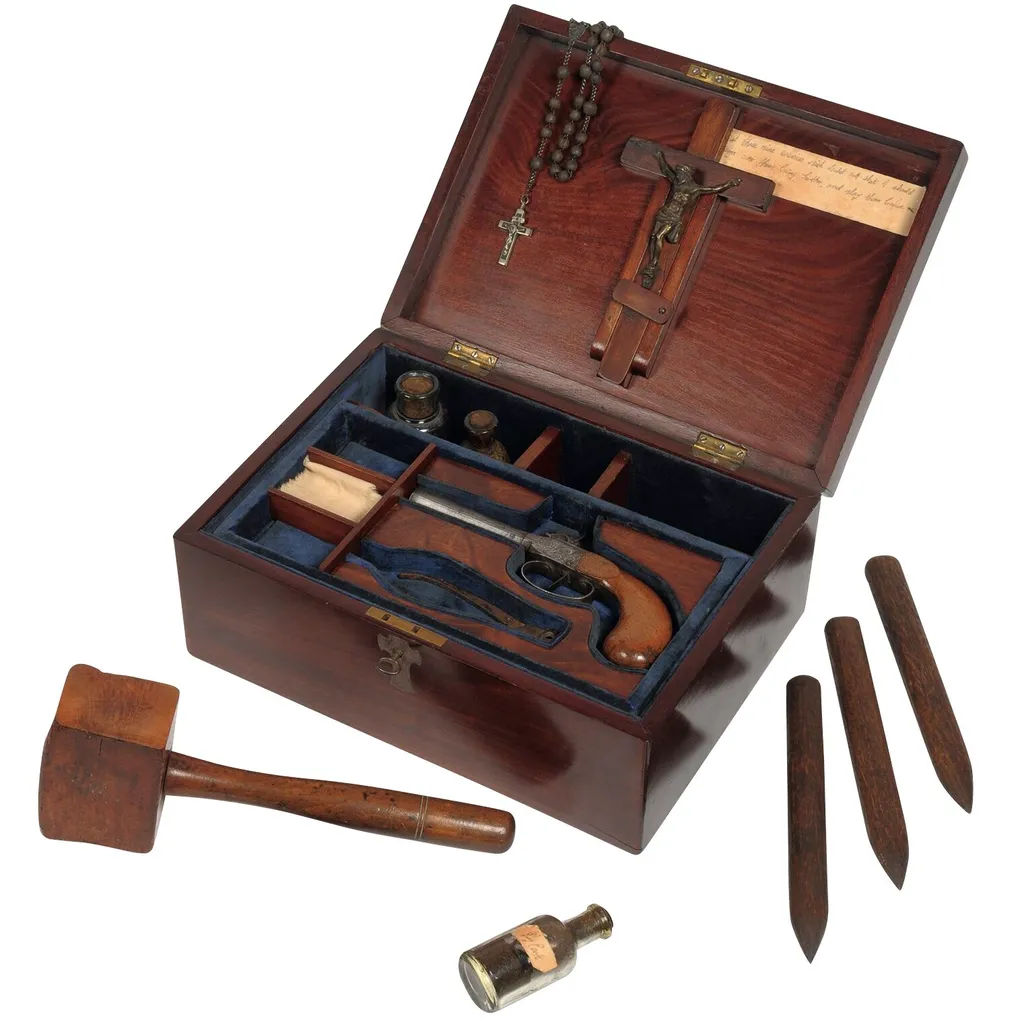It’s that time of year again, when ghoulies and ghosties walk abroad and things go bump in the night. I used to love Halloween. Back in the 1970s it was anunderstated, charming affair: a ghostly poem read at school, perhaps; a corny old black-and-white horror film on the television, or a spooky cartoon. One golden Halloween afternoon, my grandmother taught me to carve little turnip lanterns. That was about it.I doubt my parents were even aware of the significance of the date.
These days I’ve got mixed feelings. Halloween’s everywhere. The shops are full of tacky merchandise, and gangs of masked teenagers roam the streets demanding ‘Halloween candy’. Every year I barricade our front door and Venetia hangs out the garlic – we turn off the lights and pretend we’ve gone to Positano for the week. This year, I’m tempted to buy an ‘antique’ vampire hunter’s kit to ward them off. That’s if I could ever afford one.
Do you know about these kits? They come up for sale at auction from time to time. They’re great fun. There’s usually a fitted, velvet-lined Victorian mahogany box containing all manner of useful goodies forslaying vampires:silver crucifixes,stakes, woodenmallets, bibles andprayer books, little glass vials (for the holy water), silver bullet moulds, rosary beads and percussion cap pistols.
And the prices ain’t cheap. In 2010 a ‘vampire killing kit’ sold at Christie’s South Kensington for £6,000 and, two years later, a ‘vampire slaying kit’ sold at Tennants for £7,500 before ending up in the collection of the Royal Armouries in Leeds.

That’s all fine, as long as you understand that as ‘kits’ they’re about as old as that dog-eared Dennis Wheatley paperback found for sale at a summer fete. They’re fake. Or, to be fair to the auction houses, they’re ‘composites’ – made up from genuine 19th-century boxes, antique pistols and vintage paraphernalia, fitted together with skill at a later date.
The first vampire slaying kit is thought to have appeared for sale in the United States in 1986, attributed to a mysterious Professor Blomberg and one Nicolas Plomdeur, gunsmith of Liège, Belgium. Others followed.
Some believed they were novelty items, sold off the back of Bram Stoker’s Dracula to well-heeled touriststravelling across Eastern Europe in the early 20thcentury. It’s a nice idea, but there’s one little snag. The kitstypically include pistols and moulds to make silver bullets.But, as those of you who know your horror films will remember, silver bullets are for slaying werewolves, not vampires. The idea that you could kill a vampire with a silver bullet only took hold in the popular imagination following the release of Hammer’s The Satanic Rites of Dracula in 1973.
Which reminds me. Fakery. At some stage in your collecting adventure, you are going to encounter deliberate fakery. So often it’s the optimistic beginner who ends up buying the so-called antique with dubious provenance: the too-good-to-be-true Sunderland lustre jug or the ‘18th- century’ apple tea caddy. But, even if you do end up buying a fake, it will, at least, allow you to handle the object at leisure.
In time, commonplace fakes will look blindingly obvious, and you’ll wonder why you ever took them seriously in the first place. But that’s the joy of collecting. It’s a constant learning curve and, as the experts admit, the more you know, the more you realise how much you don’t know.
